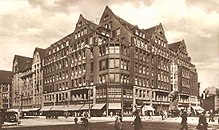South Sea House
The Südseehaus is an office building in Hamburg built in 1911 . It is located on the properties Mönckebergstrasse 6, Lange Mühren and Spitalerstrasse 6.
history
As early as 1897, the Hamburg Senate decided to redesign the Gängeviertel as a modern district. After the completion of Hamburg's main train station in 1906 and in connection with the planned breakthrough in Mönchebergstrasse, including the construction of the subway , the plots between Spitalerstrasse and the new Mönckebergstrasse with construction obligations were auctioned to those willing to build. On January 26, 1911, four entrepreneurs who were friends came together on the Hamburg stock exchange : the project developer Franz Albert Bach , the Swiss consul Johann Maegli and the import and export merchants Otto Friedrich Bock and Eduard Hurry Ringel . They acquired the 2,657 m² property between Mönckebergstrasse, Schweinemarkt and Spitalerstrasse for 1,661,100 Reichsmarks . They had already commissioned the renowned Hamburg architect Carl Gustav Bensel with the planning , who was able to submit a design in the traditional style requested by the city, which was agreed with the city. The house was completed within just one year.
When it opened in 1912, 54 office units and shops had already been let. Among them were Schlubach & Co. , founded by Heinrich August Schlubach , whose son Roderich was married to Eduards Ringel's daughter Harriett, and the Central American Plantagen Corporation . Since Ringel was also involved in the South America business, the house was called "South Sea House". Other tenants were the "Jute-Spinnerei und Weberei, Plan und Sackfabrik" of the entrepreneur and DDP politician Max Bahr , a representative of the Hannoversche Waggonfabrik for electric cars, the Hamburg-Mannheimer Versicherung , the Albingia insurance company and other import and export companies, brokers u. a. The shops on the ground floor were rented to sophisticated textile and luxury food stores, including the Ernst von Spreckelsen fashion house .
In the 1920s, some agencies from foreign companies were added as new tenants. a. a branch of the security lock manufacturer Yale and the representation of the US company "Markt & Co.", led by show jumper Eduard Pulvermann . In 1930, Schlubach & Co had to file for bankruptcy as a result of the banking crisis .
The Südseehaus was also badly damaged in the air raids on Hamburg in the summer of 1943. In 1944 there were only four tenants, one of whom was the police chief, for the use of the cellar for air raid protection . The facades with the characteristic four gables were retained, however, and the roofs were resealed in the first few years after the war. In 1949 a new tenant moved in, the Peek & Cloppenburg fashion store , which gradually expanded into the house. In 1958 the house was completely renovated and modernized by the Hamburg architect Titus Felixmüller . The gables were removed and replaced by two staggered floors, of which the upper one was clad with copper and provided with a pergola.
In 2016 the entire Südseehaus was rented to Peek & Cloppenburg. The administrators and co-owners are now the great-grandchildren of the project developer Franz Albert Bach, Claudia Bach and Mathias Bach, who u. a. also own shares in the Levantehaus .
literature
- Michael Seufert: 100 years of the South Sea House. Edited by Mathias Bach, Hamburg 2016
Web links
Individual evidence
- ↑ Hans-Juergen Fink: Claudia Bach is the mistress in the office building. Hamburger Abendblatt , February 13, 2013
Coordinates: 53 ° 33 '7.3 " N , 10 ° 0' 15.2" E



